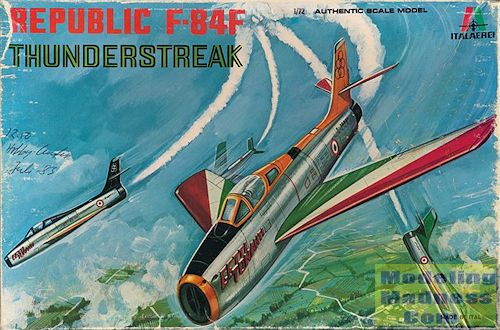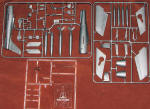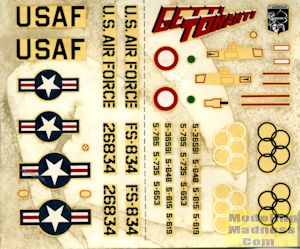
Italaerie 1/72 F-84F Thunderstreak
|
KIT # |
107 |
|
PRICE: |
$4.00 from the 'junk kit' table. |
|
DECALS: |
Three aircraft |
|
REVIEW : |
|
|
NOTES: |
` |

|
HISTORY |
In 1949, a swept wing version of the F-84 was created with the hope of bringing performance to the level of the F-86. The last production F-84E was fitted with a swept tail, a new wing with 38.5 degrees of leading edge sweep and 3.5 degrees of anhedral, and a J35-A-25 engine producing 5,300 pound-force (23.58 kN) of thrust. The aircraft was designated XF-96A. It flew on 3 June 1950 with Otto P. Haas at the controls. Although the airplane was capable of 602 knots (693 mph, 1,115 km/h), the performance gain over the F-84E was considered minor. Nonetheless, it was ordered into production in July 1950 as the F-84F Thunderstreak. The F-84 designation was retained because the fighter was expected to be a low-cost improvement of the straight-wing Thunderjet with over 55 percent commonality in tooling.
In the meantime, the USAF, hoping for improved high-altitude performance from a more powerful engine, arranged for the British Armstrong Siddeley Sapphire turbojet engine to be built in the United States as the Wright J65. To accommodate the larger engine, YF-84Fs with a British-built Sapphire as well as production F-84Fs with the J65 had a vertically stretched fuselage, with the air intake attaining an oval cross-section. Production delays with the F-84F forced the USAF to order a number of straight-wing F-84Gs as an interim measure.
Production quickly ran into problems. Although tooling commonality with the Thunderjet was supposed to be 55 percent, in reality only fifteen percent of tools could be reused. To make matters worse, the F-84F utilized press-forged wing spars and ribs. At the time, only three presses in the United States could manufacture these, and priority was given to the Boeing B-47 Stratojet bomber over the F-84. The YJ65-W-1 engine was considered obsolete and the improved J65-W-3 did not become available until 1954. When the first production F-84F finally flew on 22 November 1952, it differed from the service test aircraft. It had a different canopy which opened up and back instead of sliding to the rear, as well as airbrakes on the sides of the fuselage instead of the bottom of the aircraft. The aircraft was considered not ready for operational deployment due to control and stability problems. The first 275 aircraft, equipped with conventional stabilizer-elevator tailplanes, suffered from accelerated stall pitch-up and poor turning ability at combat speeds. Beginning with Block 25, the problem was ameliorated by the introduction of a hydraulically powered one-piece stabilator. A number of aircraft were also retrofitted with spoilers for improved high-speed control. As a result, the F-84F was not declared operational until 12 May 1954.
Project Run In completed operational tests in November 1954 and found the aircraft to be to USAF satisfaction and considerably better than the F-84G. However, ongoing engine failures resulted in the entire fleet being grounded in early 1955. Also, the J65 engine continued to suffer from flameouts when flying through heavy rain or snow. As the result of the problems, the active duty phaseout began almost as soon as the F-84F entered service in 1954, and was completed by 1958. Increased tensions in Germany associated with construction of the Berlin Wall in 1961 resulted in reactivation of the F-84F fleet. In 1962, the fleet was grounded due to the corrosion of control rods. A total of 1,800 man hours were expended to bring each aircraft to full operational capacity. Stress corrosion eventually forced the retirement of ANG F-84Fs in 1971.
In what is probably one of the very few air-to-air engagements involving the F-84F, two Turkish Air Force F-84F Thunderstreaks shot down two Iraqi Il-28 Beagle bombers that crossed the Turkish border by mistake during a bombing operation against Iraqi Kurdish insurgents. This engagement took place on 16 August 1962.
The F-84F was retired from active service in 1964, and replaced by the North American F-100 Super Sabre and relegated to duty in the Air National Guard. The last F-84F Thunderstreak retired from the ANG in 1971. Three Hellenic Air Force RF-84Fs that were retired in 1991 were the last operational F-84s.
|
THE KIT |
The kit itself has three sprues of which one is clear. This is a kit of the
raised panel line era and I am pretty sure it is from the early 1970s as the box
has the old Italaerie spelling of the company name on it. There is little in the
way of cockpit detail, which basically consists of a seat shape, a rear bulkhead
on which to place the seat, and a pilot to put in the seat. No floor, no control
stick, no rudder pedals. There is a space for an instrument panel on the
anti-glare panel. I know of no aftermarket cockpit.
Since Italeri has also boxed this as an RF-84F, there is a separate nose. Weight
needs to be placed into the nose gear well halves which also form the intake
interior. I suggest filling it. The wheel wells in the wing are not boxed in.
Wings are two upper and lower sections that are joined and fit into the
fuselage. The fuselage has separate speed brakes, but no actuators. There is no
jet pipe so it may be wise to either make one or put in a blanking plate to
prevent see-through. For things under wings, you have four wing pylons and four
large fuel tanks.
Main gear is molded into one of the gear doors and the separate wheels are then
cemented to the axles on the door. The nose gear and wheel is a single piece.
The kit does comes with the ability to build it with the wheels up. There is a
separate windscreen and canopy. The canopy can be posed open, though there is
really nothing to see in the cockpit. The kit does come with a display stand.
CONCLUSIONS I have built quite a few of these in the past. I like the
kit despite its lack of detail and you can see some of those builds
at this link. I have also built the
Airfix kit and when you look at the two, you will notice that the Italeri kit
has a wider canopy. I have been told that the entire fuselage on the Italeri kit
is too wide. That may well be the case, but of the two, it is still the one I'd
build first.  The
F-84F has not been served all that well by kit makers in 1/72 scale. Your editor
can only think of two mainstream kits produced of this aircraft in this scale
and those are by Airfix and Italeri. There may well have been resin kits and I
believe that PJ Production did one.
The
F-84F has not been served all that well by kit makers in 1/72 scale. Your editor
can only think of two mainstream kits produced of this aircraft in this scale
and those are by Airfix and Italeri. There may well have been resin kits and I
believe that PJ Production did one.
 Instructions
in my kit consist of four construction steps and no 'underway' color
information. There are markings for two planes. One is a generic USAF aircraft
in unpainted metal while the other livery option is for the Italian aerobatic
team that was formed for the Olympic Games. There are options for several
different serial numbers and these planes were all painted with different color
upper fuselages and fins, the wings being in the Italian Tricolor. The decals in
my kit were trash, the reason the kit was only $4.00, however, there have been
sheets offered that feature this aircraft, so I will at least be able to build
it.
Instructions
in my kit consist of four construction steps and no 'underway' color
information. There are markings for two planes. One is a generic USAF aircraft
in unpainted metal while the other livery option is for the Italian aerobatic
team that was formed for the Olympic Games. There are options for several
different serial numbers and these planes were all painted with different color
upper fuselages and fins, the wings being in the Italian Tricolor. The decals in
my kit were trash, the reason the kit was only $4.00, however, there have been
sheets offered that feature this aircraft, so I will at least be able to build
it.
|
REFERENCE |
http://en.wikipedia.org/wiki/Republic_F-84F_Thunderstreak
January 2015
Preview kit thanks to my inherent cheapness.
If you would like your product reviewed fairly and quickly, please contact me or see other details in the Note to Contributors.
Back to the Previews Index Page